The United States and Europe this week celebrated some form of “Victory in Europe Day,” or V-E Day, to mark the 80th anniversary of Adolf Hitler’s downfall and Nazi Germany’s surrender to Allied forces.
Despite all the jubilation 80 years ago on May 8, 1945, however, there was still unfinished business to attend to. Soviet forces were already being transferred via Trans-Siberian Railroad to Japanese-held Manchukuo, a British army was battling its way into Burma (now Myanmar) and a Royal Navy task force was assisting its American allies in taking Okinawa, the last major island standing between the Allies and the receding empire of Japan. There, U.S. and Royal navies fought for survival against suicidal airmen, called kamikazes, while Japanese forces put up a stubborn fighting retreat designed to slow the Allied advance while inflicting as many casualties as possible.
Among the thousands involved in World War II’s last acts was Pfc. Clarence Byrle Craft, a rifleman in Company G, 2nd Battalion, 382nd Regiment, 96th Infantry Division. In May 1945, Craft’s company was pinned in place on Okinawa by a 450-foot-high patch of high ground that the Americans called Hen Hill. It was a key chess piece that represented a potential breakthrough that the Americans were grimly determined to achieve and the Japanese were desperate to prevent. On May 31, 1945, Craft led several men on a reconnaissance of Hen Hill. What followed would exceed everyone’s expectations.
Craft was born in San Bernardino, California, on Sept. 23, 1921. His father died when he was around 8 years old and his mother was a cook in a restaurant chain, ultimately settling in Santa Ana. Craft worked as a ranch foreman until Sept. 15, 1944, when he enlisted in the U.S. Army. Before shipping out to the Pacific, he got married.
In April 1945, Craft arrived at Okinawa, where he experienced combat for the first time. On May 31, Craft checked what resistance Hen Hill still presented and was not far along when he got an answer — in the form of heavy gunfire and grenades, which wounded three of his troops. Standing up in full view of enemy forces, Craft advanced, shooting at any sign of hostile movement until he’d driven Japanese troops into their trenches. Reaching the hilltop, he threw some grenades into the enemy positions
He was joined by his remaining troops who, following his lead, carried up cases of explosives. Between hurling explosives at enemy positions on the other side of the hillcrest, Craft directed his men as to where to lob their grenades. Craft then moved on to attack the main trench and, straddling a deep ditch, fired into it at point-blank range. He was chasing the stunned survivors as they fled when he came upon an enemy machine gun nest, which he eliminated with rifle and grenades.
One of Craft’s troops caught up to see him moving down the central trench to a camouflaged cave mouth and passed him a bag of explosives, which Craft threw into the cave — only to see it fail to detonate. Reaching down, Craft recovered the explosive, relit it and heaved it back into the cave. This time it blew, entombing any enemy troops seeking shelter there.
Craft was credited with at least 25 enemy kills, but many in his outfit opined that his seemingly suicidal advance to secure Hen Hill had unhinged the entire Japanese defensive line, hastening the Allied victory on Okinawa. Ironically, shortly afterward, Craft was withdrawn to Guam for two months, convalescing with typhoid fever.
Returning home in September 1945 — after Japan’s surrender and the end of World War II — Craft trained soldiers at Fort Ord, near Monterey, California. On Oct. 12, he was called to the White House, where he received the Medal of Honor from President Harry Truman alongside 14 other Medal of Honor recipients.
Craft was honorably discharged in 1946, but he soon reenlisted for several more years, encompassing the Korean War.
In the 1960s, he moved to Fayetteville, Arkansas, where he lived with his second wife and worked in construction. During that time, a janitor named Jim Wronski reportedly found Craft’s Medal of Honor and Bronze Star citations in a trash can in Southern California and after 10 years of tracking him down, found him and returned them.
Craft spent some of his retirement working at the Fayetteville Veterans Affairs Medical Center, which named its primary care unit after him in 1998.
Craft died on March 28, 2002, and is buried in the Fayetteville National Cemetery.
Read the full article here
